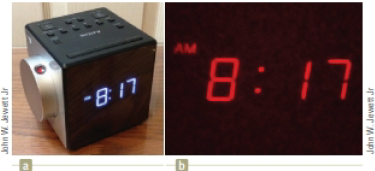
Concept explainers
You are working for an electronics company that makes devices for the home. Your supervisor has given you an assignment to help design the projection mechanism for a projection alarm clock. In this type of clock, a projection system is mounted on the body of the clock, as shown in Figure P35.31a, where the projection system is the silver cylinder, of radius R = 3.25 cm, mounted on the left side of the clock. A converging lens is mounted on the edge of the cylinder. Inside the cylinder, a small digital display of the time in red characters can be moved from the center of the cylinder outward radially toward the lens. The red light of the digital display can he seen in the lens in Figure P35.31a. As a result, an image of the time is projected in red onto the ceiling or wall of a darkened room (Fig. P35.31b). The range of distances for focused images of the digital display is from 0.500 m to 4.00 m, measured from the center of the cylinder. For the smallest value of the range, the digital display is at the center of the cylinder. You must determine for your supervisor the following parameters for the design of the projection system: (a) the focal length of the lens and (b) the distance of the digital display from the center of the cylinder for the largest value of the range.
Figure P35.31

Want to see the full answer?
Check out a sample textbook solution
Chapter 35 Solutions
Physics for Scientists and Engineers
- Estimate the diameter of the Moon. During a total solar eclipse, the Moon passes in front of the Sun so that during “totality” their apparent sizes match and the Moon blocks light from the Sun shining on the Earth. a) What do you predict the size of the Moon would be if you were to use a pinhole in an aluminum holder, meter stick, and white paper screen to project light from the full Moon through a pinhole onto a screen that is one meter away from the pinhole? b) Describe in detail how you would use this apparatus and your knowledge of pinhole phenomena to estimate the diameter of the Moon. Assume that the distance between the Earth and the Moon is 250,000 miles.arrow_forwardThe following data was collected for a friction experiment in which an object was observed moving at constant speed over a surface. Graph the Applied Force versus the Normal Force and determine the coefficient of friction. Is this value the coefficient of kinetic friction or the coefficient of static friction? Justify your answer. Trial Normal Force Applied Force 1 4.13 1.44 2 6.41 1.68 3 8.94 2.82 4 11.34 3.94 5 13.82 5.05arrow_forward1. Measurements and Linear Regression 1.1 Introduction The objective of this lab assignment is to represent measurement data in graphical form in order to illustrate experimental data and uncertainty visually. It is often convenient to represent experimental data graphically, not only for reporting results but also to compute or measure several physical parameters. For example, consider two physical quantities represented by x and y that are linearly related according to the algebraic relationship, y=mx+b, (1.1) where m is the slope of the line and b is the y-intercept. In order to assess the linearity between y and x, it is convenient to plot these quantities in a y versus x graph, as shown in Figure 1.1. Datapoints Line of regression Figure 1.1: Best fit line example. Once the data points are plotted, it is necessary to draw a "best fit line" or "regression line" that describes the data. A best fit line is a straight line that is the best approximation of the given set of data, and…arrow_forward
- Please help with Statistical Analysis table. These are trials from a Newton's Laws of Motion lab, please help with standard deviation and margin of error. Thanks!arrow_forwardplease solve and answer the question correctly. thank you!!arrow_forwardplease solve and answer the question correctly. thank you!!arrow_forward
- Newton's Laws of Motion - Please help with the first angle calculations of standard deviation and margin of error. I just need a model and I can figure out the other two angles. Thanks!arrow_forward2. A battleship simultaneously fires two shells at enemy ships. If the shells follow the parabolic trajectories shown, which ship gets hit first? a. A b. both at the same time C. B d. need more information battleship Barrow_forwardA m₁ = 1.70-kg aluminum block and a m₂ = 8.00-kg copper block are connected by a light string over a frictionless pulley. The two blocks are allowed to move on a fixed steel block wedge (of angle 0 = 31.5°) as shown in the figure. (For aluminum on steel, μk k = 0.36.) Мк Aluminum m Copper = 0.47. For copper on steel, Steel m2 Ꮎ (a) the acceleration of the two blocks m/s² (b) the tension in the string Narrow_forward
 Physics for Scientists and EngineersPhysicsISBN:9781337553278Author:Raymond A. Serway, John W. JewettPublisher:Cengage Learning
Physics for Scientists and EngineersPhysicsISBN:9781337553278Author:Raymond A. Serway, John W. JewettPublisher:Cengage Learning Physics for Scientists and Engineers with Modern ...PhysicsISBN:9781337553292Author:Raymond A. Serway, John W. JewettPublisher:Cengage Learning
Physics for Scientists and Engineers with Modern ...PhysicsISBN:9781337553292Author:Raymond A. Serway, John W. JewettPublisher:Cengage Learning Physics for Scientists and Engineers: Foundations...PhysicsISBN:9781133939146Author:Katz, Debora M.Publisher:Cengage Learning
Physics for Scientists and Engineers: Foundations...PhysicsISBN:9781133939146Author:Katz, Debora M.Publisher:Cengage Learning College PhysicsPhysicsISBN:9781285737027Author:Raymond A. Serway, Chris VuillePublisher:Cengage Learning
College PhysicsPhysicsISBN:9781285737027Author:Raymond A. Serway, Chris VuillePublisher:Cengage Learning Physics for Scientists and Engineers, Technology ...PhysicsISBN:9781305116399Author:Raymond A. Serway, John W. JewettPublisher:Cengage Learning
Physics for Scientists and Engineers, Technology ...PhysicsISBN:9781305116399Author:Raymond A. Serway, John W. JewettPublisher:Cengage Learning Principles of Physics: A Calculus-Based TextPhysicsISBN:9781133104261Author:Raymond A. Serway, John W. JewettPublisher:Cengage Learning
Principles of Physics: A Calculus-Based TextPhysicsISBN:9781133104261Author:Raymond A. Serway, John W. JewettPublisher:Cengage Learning





